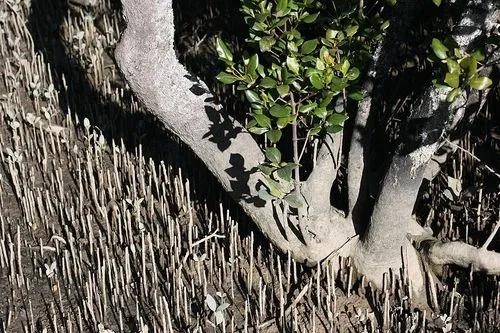Viburnum prunifolium (known as blackhaw or black haw, blackhaw viburnum, sweet haw, and stag bush) is a species of Viburnum native to eastern North America, from Connecticut west to eastern Kansas, and south to Alabama and Texas. It is a deciduous shrub or small tree growing to 2–9 metres (7–30 ft) tall with a short crooked trunk and stout spreading branches; in the northern parts of its range, it is a shrub, becoming a small tree in the southern parts of its range. The bark is reddish-brown, very rough on old stems. The branchlets are red at first, then green, finally dark brown tinged with red. The winter buds are coated with rusty tomentum. The flower buds ovate, 1 cm long, much larger than the axillary buds. The leaves are simple, up to 9 cm long and 6 cm broad, oval, ovate or orbicular, wedge-shaped or rounded at base, serrate, acute, with serrated edges with a grooved and slightly winged red petiole 1.5 cm long; they turn red in fall. The leaves are superficially similar to some species of Prunus (thus "prunifolium"); they come out of the bud involute, shining, green, tinged with red, sometimes smooth, or clothed with rusty tomentum; when full grown dark green and smooth above, pale, smooth or tomentose beneath.
Blackhaw Care
Viburnum Prunifolium



This is a branched woody shrub or small tree up to 15' tall. The young bark of small branches is gray and slightly rough, while the old bark of the trunk or larger branches is grey and rough with flat-topped plates. The opposite leaves are up to 3" long and 1" across; they are ovate or ovate-obovate, glabrous on both their lower and upper sides, and finely serrated along their margins. The slender petioles are up to 1" long and reddish. The buds of these leaves are short. Cymes of flowers about 3-5" across develop from the axils of the leaves; each cyme is much branched, but sessile at the base. Each flower is about ¼" across; it has 5 white petals that are well-rounded and longer than the sepals. There are 5 long stamens with slender white filaments and yellow anthers, and a small pistil at the center of the flower that is cream-colored at the base. The blooming period occurs from mid- to late spring. The flowers have a strong and pleasant fragrance; they are produced at about the same time as the leaves. Each flower is replaced by a fleshy ovoid drupe about 1/3" (8 mm.) long; this drupe becomes blue-black at maturity, sometimes with a whitish bloom. Inside each drupe, there is a single stone (a seed with a hard coat) that is flat on one side and convex on the other. The drupes are sweet and edible, although somewhat thin-fleshed because of their stones. The root system consists of a branching woody taproot.
How to Care for the Plant

Popularity

146 people already have this plant 16 people have added this plant to their wishlists
Discover more plants with the list below
Popular articles






